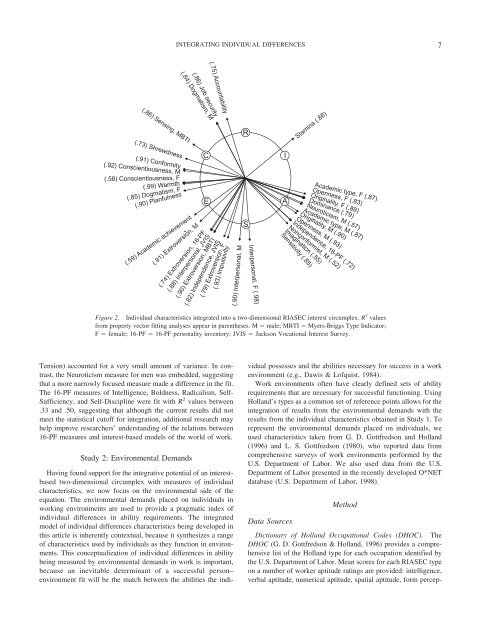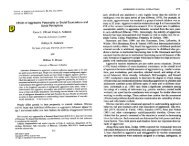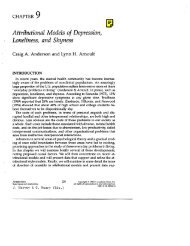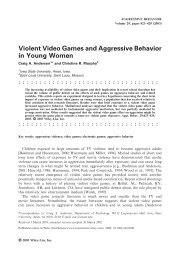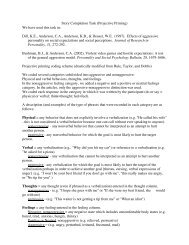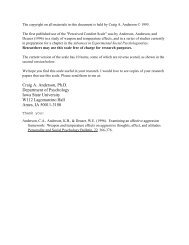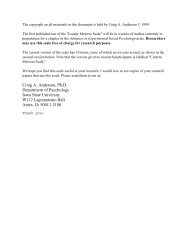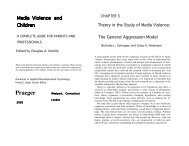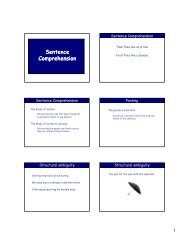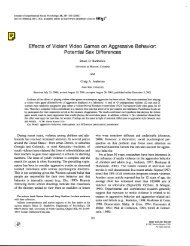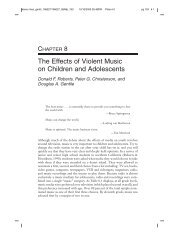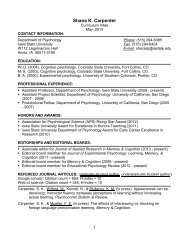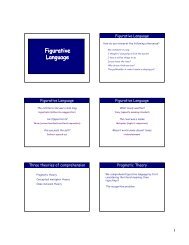Holland's RIASEC Model as an Integrative Framework for Individual ...
Holland's RIASEC Model as an Integrative Framework for Individual ...
Holland's RIASEC Model as an Integrative Framework for Individual ...
Create successful ePaper yourself
Turn your PDF publications into a flip-book with our unique Google optimized e-Paper software.
INTEGRATING INDIVIDUAL DIFFERENCES<br />
7<br />
Figure 2. <strong>Individual</strong> characteristics integrated into a two-dimensional <strong>RIASEC</strong> interest circumplex. R 2 values<br />
from property vector fitting <strong>an</strong>alyses appear in parentheses. M male; MBTI Myers-Briggs Type Indicator;<br />
F female; 16-PF 16-PF personality inventory; JVIS Jackson Vocational Interest Survey.<br />
Tension) accounted <strong>for</strong> a very small amount of vari<strong>an</strong>ce. In contr<strong>as</strong>t,<br />
the Neuroticism me<strong>as</strong>ure <strong>for</strong> men w<strong>as</strong> embedded, suggesting<br />
that a more narrowly focused me<strong>as</strong>ure made a difference in the fit.<br />
The 16-PF me<strong>as</strong>ures of Intelligence, Boldness, Radicalism, Self-<br />
Sufficiency, <strong>an</strong>d Self-Discipline were fit with R 2 values between<br />
.33 <strong>an</strong>d .50, suggesting that although the current results did not<br />
meet the statistical cutoff <strong>for</strong> integration, additional research may<br />
help improve researchers’ underst<strong>an</strong>ding of the relations between<br />
16-PF me<strong>as</strong>ures <strong>an</strong>d interest-b<strong>as</strong>ed models of the world of work.<br />
Study 2: Environmental Dem<strong>an</strong>ds<br />
Having found support <strong>for</strong> the integrative potential of <strong>an</strong> interestb<strong>as</strong>ed<br />
two-dimensional circumplex with me<strong>as</strong>ures of individual<br />
characteristics, we now focus on the environmental side of the<br />
equation. The environmental dem<strong>an</strong>ds placed on individuals in<br />
working environments are used to provide a pragmatic index of<br />
individual differences in ability requirements. The integrated<br />
model of individual differences characteristics being developed in<br />
this article is inherently contextual, because it synthesizes a r<strong>an</strong>ge<br />
of characteristics used by individuals <strong>as</strong> they function in environments.<br />
This conceptualization of individual differences in ability<br />
being me<strong>as</strong>ured by environmental dem<strong>an</strong>ds in work is import<strong>an</strong>t,<br />
because <strong>an</strong> inevitable determin<strong>an</strong>t of a successful person–<br />
environment fit will be the match between the abilities the individual<br />
possesses <strong>an</strong>d the abilities necessary <strong>for</strong> success in a work<br />
environment (e.g., Dawis & Lofquist, 1984).<br />
Work environments often have clearly defined sets of ability<br />
requirements that are necessary <strong>for</strong> successful functioning. Using<br />
Holl<strong>an</strong>d’s types <strong>as</strong> a common set of reference points allows <strong>for</strong> the<br />
integration of results from the environmental dem<strong>an</strong>ds with the<br />
results from the individual characteristics obtained in Study 1. To<br />
represent the environmental dem<strong>an</strong>ds placed on individuals, we<br />
used characteristics taken from G. D. Gottfredson <strong>an</strong>d Holl<strong>an</strong>d<br />
(1996) <strong>an</strong>d L. S. Gottfredson (1980), who reported data from<br />
comprehensive surveys of work environments per<strong>for</strong>med by the<br />
U.S. Department of Labor. We also used data from the U.S.<br />
Department of Labor presented in the recently developed O*NET<br />
datab<strong>as</strong>e (U.S. Department of Labor, 1998).<br />
Method<br />
Data Sources<br />
Dictionary of Holl<strong>an</strong>d Occupational Codes (DHOC). The<br />
DHOC (G. D. Gottfredson & Holl<strong>an</strong>d, 1996) provides a comprehensive<br />
list of the Holl<strong>an</strong>d type <strong>for</strong> each occupation identified by<br />
the U.S. Department of Labor. Me<strong>an</strong> scores <strong>for</strong> each <strong>RIASEC</strong> type<br />
on a number of worker aptitude ratings are provided: intelligence,<br />
verbal aptitude, numerical aptitude, spatial aptitude, <strong>for</strong>m percep-


